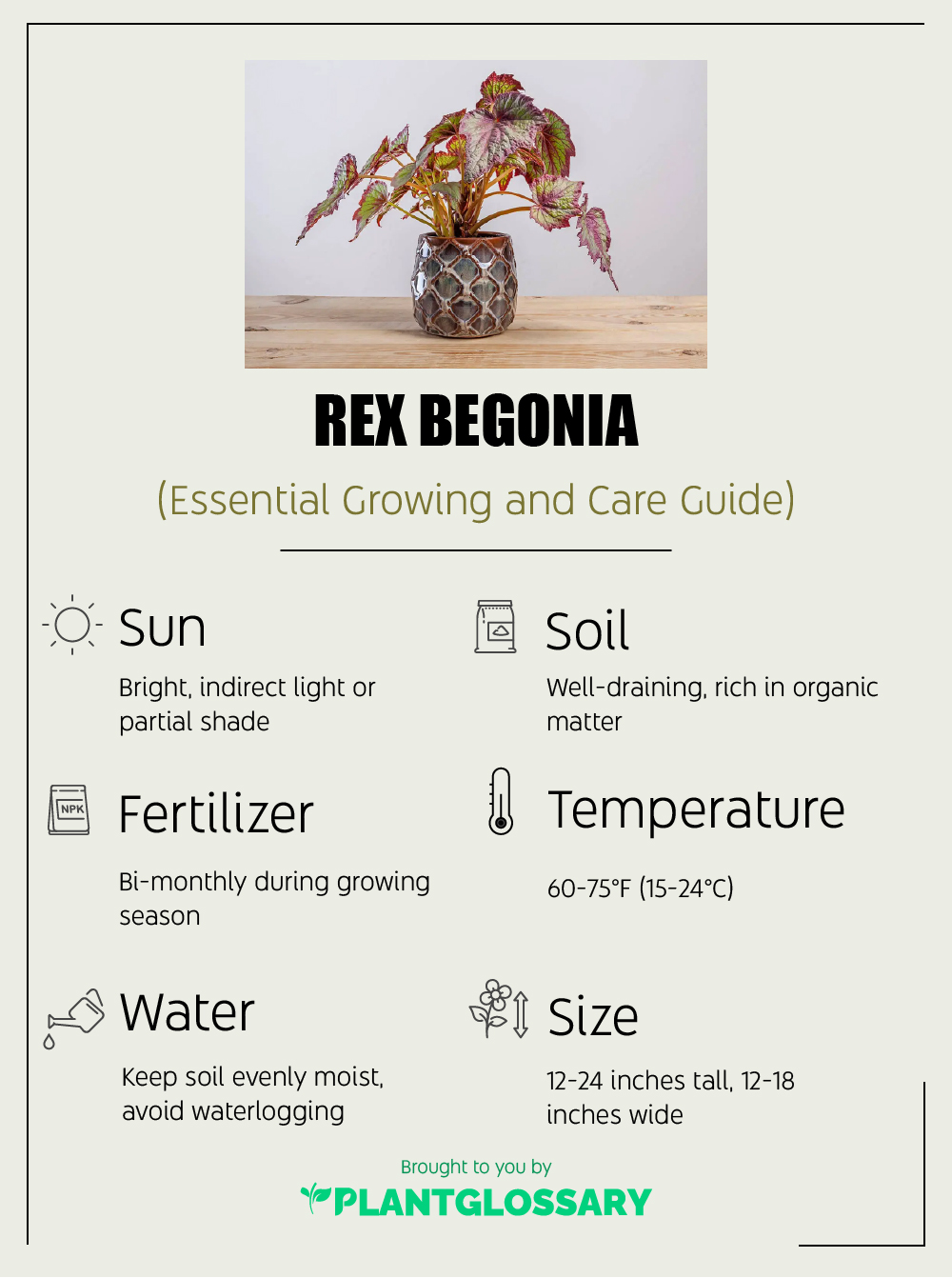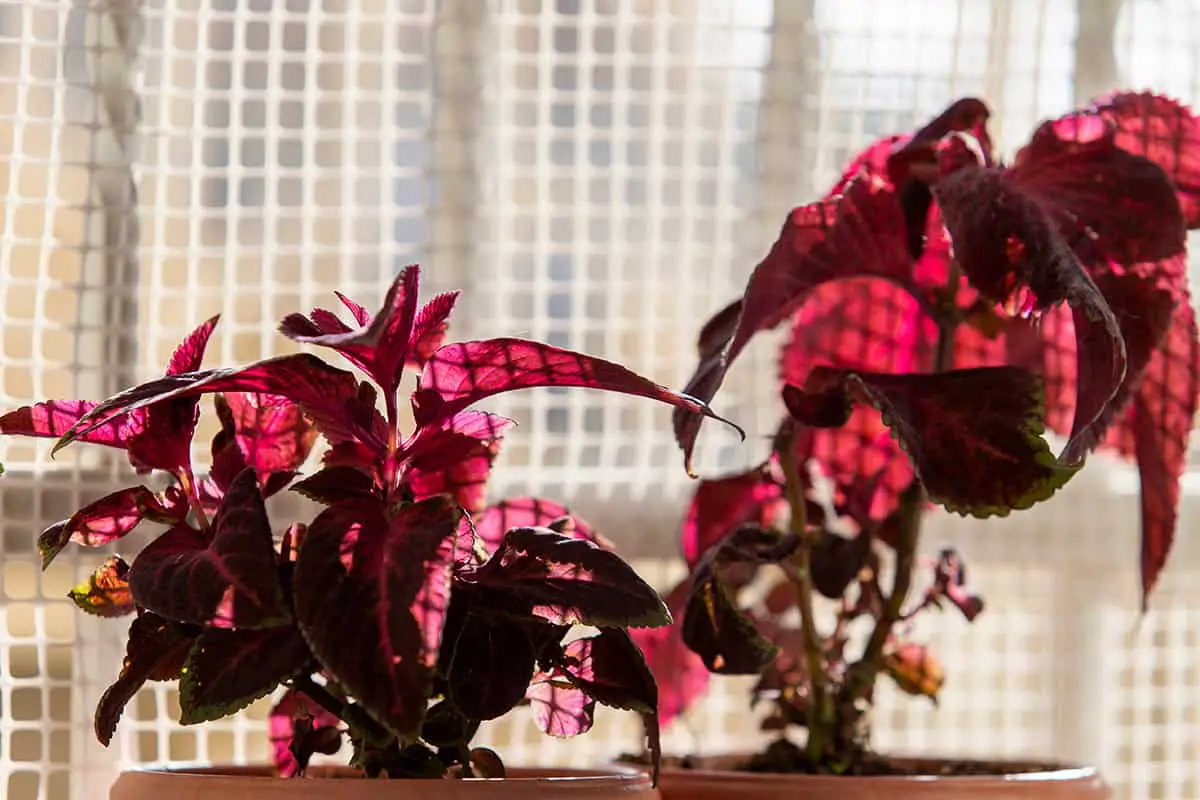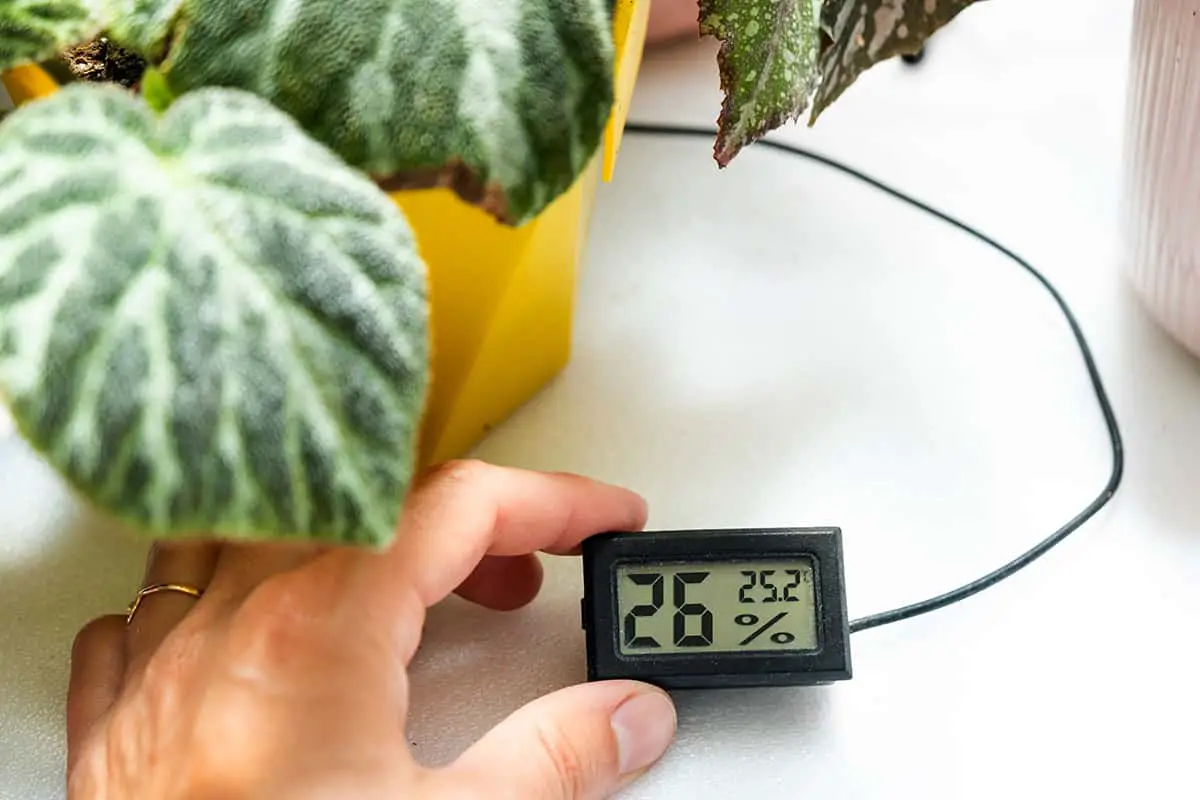You just picked up a Rex Begonia, and you’re excited to see its colorful, patterned leaves brighten up your home. A few days in, you start noticing its leaves aren’t looking as lively as they did in the store. No need to panic—this happens to many plant owners. With the right care, your Rex Begonia can thrive and bring that pop of color you want. Here’s how to care for it to make it grow healthy and strong.

Table of Contents
Light

Rex Begonia thrive in bright, but indirect light. The intense midday sun can scorch their leaves, so it’s crucial to avoid direct sunlight, especially during the peak hours. East-facing windows are usually ideal, offering the soft morning light that these plants prefer.
For optimal growth, aim for a light intensity between 1,500 to 2,200 foot candles. If you’re starting with new plants, a lower light level of around 1,000 foot candles is beneficial for the first couple of weeks. This allows them to adjust without stress.
Rex Begonias with less light may not show their vibrant colors as vividly. If you find the leaves losing their brightness, it may indicate the need for more light. Conversely, if you see signs of burning or fading, it could mean the plant is receiving too much direct sunlight and the location needs adjusting.
Soil
Rex Begonia thrives in well-draining soil. Ensure your soil is rich in organic matter. A balance of porosity and moisture retention is key. You can create the right mix by using peat, perlite, and pine bark.
Your Rex Begonia needs slightly acidic to neutral soil. Aim for a pH level between 5.5 and 7.0. Keep the soil consistently moist but not soggy. Proper soil conditions prevent root rot.
You may add compost to improve soil fertility. Regular feeding with a balanced, diluted fertilizer supports robust growth. Always follow the instructions on the fertilizer package.
Water

Rex Begonia plants prefer a balance, avoiding both over and under-watering. Aim to keep the soil consistently moist. Water your Rex Begonia when the top inch of soil feels dry to the touch.
Use room temperature water to avoid shocking the plant’s roots. Overly cold water can harm the Rex Begonia, leading to leaf damage. Make sure to water the plant at the base to keep the foliage dry, preventing potential leaf rot.
During winter, Rex Begonia requires less water. The plant enters a dormant period and over-watering during this time can lead to root rot. Monitor the soil moisture more closely and decrease watering frequency.
Ensure good drainage in your potting setup. Rex Begonias does not like to sit in waterlogged soil. A pot with drainage holes, paired with well-draining potting mix, helps excess water escape and prevents issues associated with too much moisture.
Temperature and Humidity

Rex Begonia thrives in certain conditions. Your plants need a temperature range between 60°F-80°F. At night, they prefer cooler temperatures but should not drop below 60°F.
Rex Begonia comes from tropical climates, so they enjoy high humidity. Indoor environments often lack moisture, so you need to increase humidity for your plant. To do this, place your plant on a water-filled pebble tray or use a small humidifier. Make sure the leaves stay dry to prevent disease.
In winter, the air inside homes can become dry. This affects Rex Begonias, so you need to protect them from dry air. Keep them away from heaters and drafts, as these create sudden temperature changes that can damage the leaves.
To keep your Rex Begonia healthy, maintain these temperature and humidity levels year-round.
Fertilizer
For your Rex Begonia’s health, choose a balanced liquid fertilizer. Apply it every two weeks during the active growth period, typically in spring and summer. Dilute the fertilizer to half the recommended strength to prevent root burn. In fall and winter, reduce feeding as plant growth slows down.
Ensure the soil is moist before fertilizing your Rex Begonia. This helps nutrients absorb evenly and avoids shock to the roots. If the leaves begin to lose their vibrant color, it may be a sign of over-fertilization. Flush the soil with water to remove excess nutrients.
To support robust growth in your Rex Begonia, select a fertilizer with an equal ratio of nitrogen, phosphorus, and potassium. These elements contribute to leaf development, root strength, and overall plant vigor.
Propagation

You can propagate your Rex Begonia from a leaf cutting from a healthy plant. Select a robust leaf and make a clean cut near the base. Place this cutting in moist soil or water.
Roots will develop from the base of the leaf. Patience is key. In a few weeks, new growth indicates a successful propagation. The newly rooted plant will require the same care as a mature Rex Begonia.
For accurate information on the leaf vein cutting technique, refer to “How to Propagate Houseplants by Leaf Vein Cuttings”. This method increases your success rate. Remember, moisture and warmth speed up the rooting process.
If you prefer to propagate Rex Begonia by seeds, the process involves pollen transfer from male to female flowers. After successful pollination, seeds form and can be sown in well-draining soil. Germination requires consistent humidity and temperature. Seedlings are delicate so handle them with care.
Pruning
Pruning your Rex Begonia keeps the plant healthy and maintains its attractive shape. You should prune the leaves and stems that are dead or dying. This process encourages new growth and enhances air circulation. Start by identifying the stems that need trimming.
Cut back stems that are leggy or overgrown. Make your cuts just above a leaf node to promote fuller growth. Use clean, sharp scissors or pruning shears for clean cuts. This prevents damage and potential disease.
Remove yellow or brown leaves. These could be signs of age, disease, or water stress. Regularly removing them keeps your Rex Begonia looking its best. It also redirects energy to healthier parts of the plant.
After pruning, take care of the trimmings. Dispose of them away from your other plants to avoid spreading any potential issues.
Potting and Repotting

Growing Rex Begonia successfully starts with the potting process. Select a container with ample drainage holes. Your Rex Begonia thrives in aerated soil, so a peat-based potting mix with pH levels between 5.7 and 6.4 is ideal. When potting, ensure the root ball is level with the soil surface.
Repotting your Rex Begonia is equally important and should occur every couple of years or when it outgrows its current pot. The best time to repot is in the spring. Gently remove your plant from its container, taking care not to damage the delicate roots. Increase the pot size by one to two inches in diameter, which helps support new growth.
Root health is critical, so trim away any brown, soft, or excessively long roots during repotting. Fresh potting soil replenishes nutrients, ensuring your Rex Begonia continues to produce vibrant leaves. Remember to water the plant after repotting to settle the soil around the roots.
Common Problems & Troubleshooting
When you grow Rex Begonias, you might encounter some issues. Roots can rot if the soil stays wet for too long. This often happens due to overwatering. Ensure your pot has drainage holes and the soil is well-draining.
Another problem is leaf spots. Tan spots on your Rex Begonia leaves may suggest Botrytis Blight. To avoid this, reduce humidity around your plants. Regularly remove dead leaves and flowers to improve air circulation.
Sometimes Rex Begonias can suffer from temperature stress. They thrive best between 60°F and 80°F. If temperatures fall outside this range, your plant could show signs of damage. Keep them away from cold drafts and direct hot sunlight.
In terms of pests, watch for common ones like mealybugs and spider mites. They sap energy from the leaves. You can treat these infestations with insecticidal soap or neem oil.






